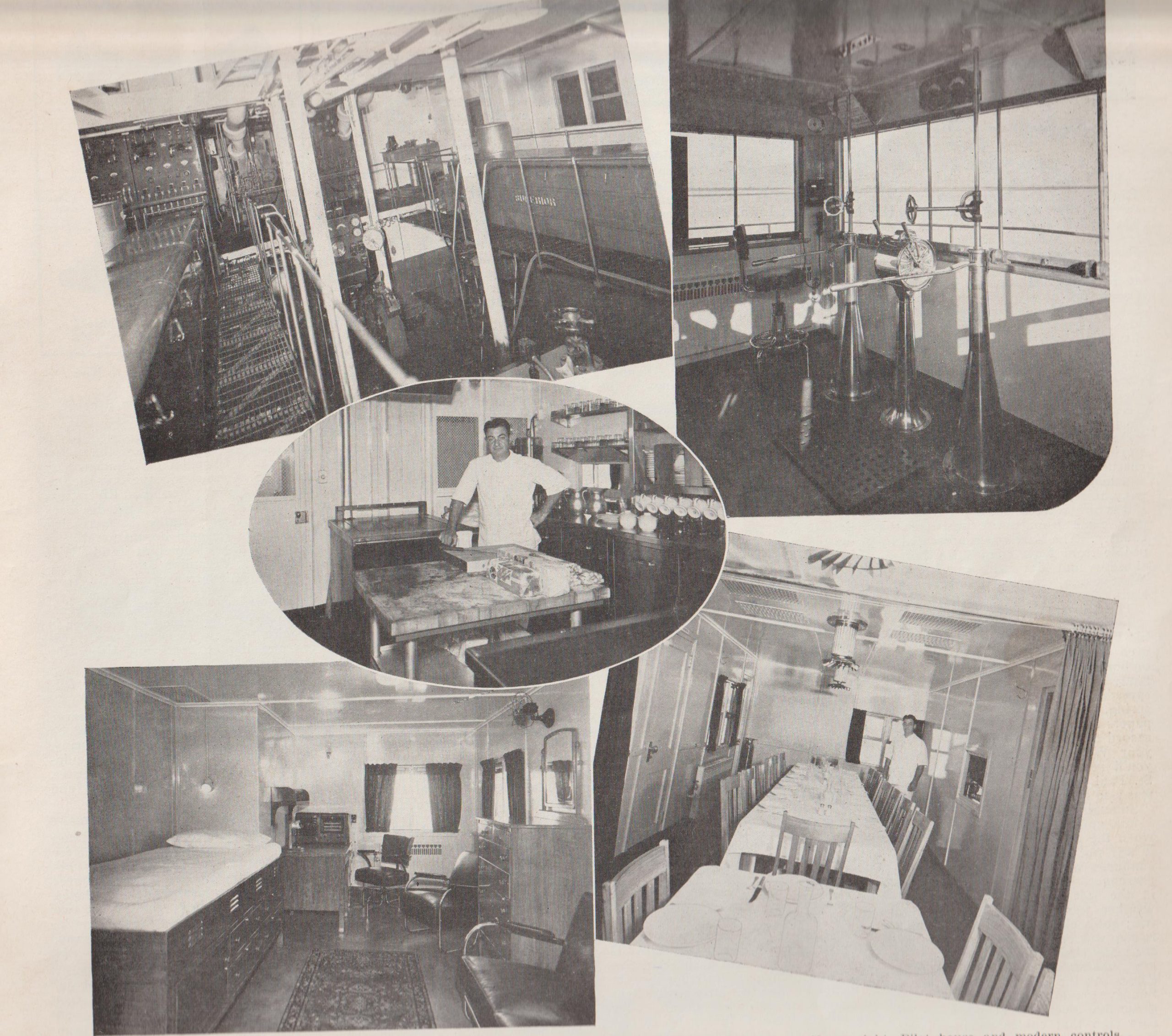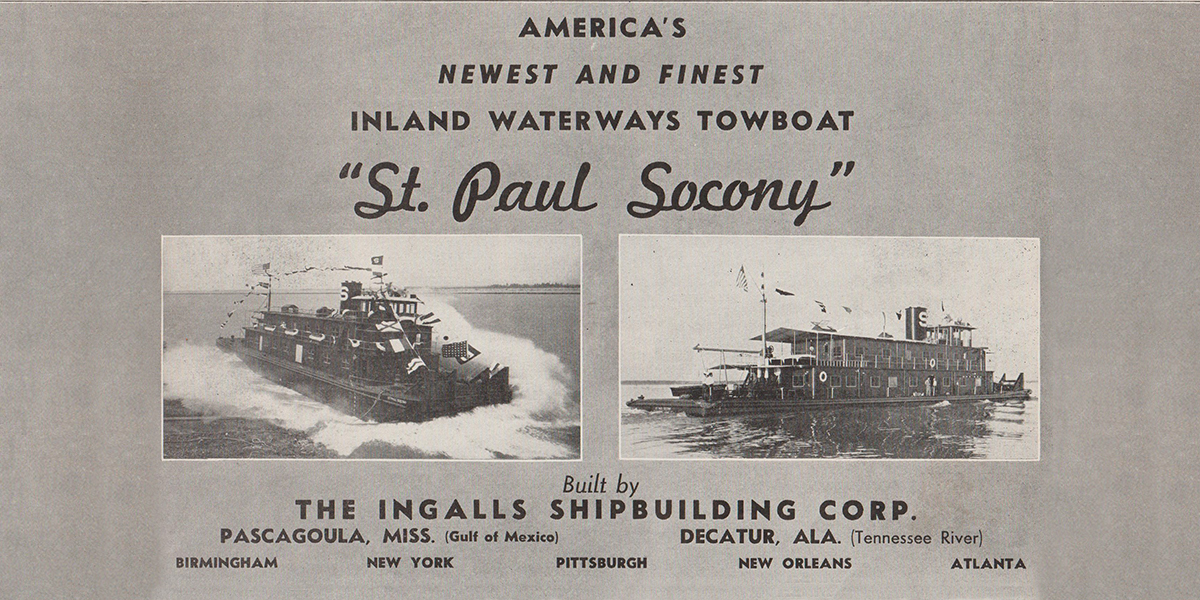In the February 5, 2024, issue of The Waterways Journal, this column detailed the St. Paul Socony, built by Ingalls in 1940 for the Socony Vacuum Oil Company of New York. “Socony” stood for “Standard Oil Company of New York.” Having recently located more information on this vessel when it came out, we will take a more in depth look at it, as well as the Socony barge fleet.
Socony entered the river towing business in 1937, when it had the 1,020 hp. Kansas City Socony and four tank barges built at Kansas City, Kan., by the Elliott-Fairfax Shipyard (WJ, September 18, 2023). This was followed in 1938 by the 1,200 hp. St. Louis Socony built by St. Louis Shipbuilding & Steel Co. (WJ, March 18, 2024). The third vessel, the largest of the fleet so far, was designed entirely by the Socony marine department.
The new boat was also touted as one of the largest and most powerful to have been built on the Tennessee River. The January 13, 1940, issue of The Waterways Journal carried a small story about the Ingalls Shipbuilding Corporation receiving a contract to build a boat for Socony at its Decatur, Ala., shipyard. The boat was launched on August 10, 1940, to much fanfare, according to the November 2, 1940, issue of The Waterways Journal. The vessel slid down the ways “gaily bedecked with flags and bunting and with the traditional champagne glistening on her bow.” The St. Paul Socony was sponsored by Mrs. Ray Reuben Irwin, and an address from David E. Lillienthal, director of the Tennessee Valley Authority, preceded the christening.

The boat had a steel hull that was 147 feet by 35 feet, and the cabins were of steel construction. The main engines for the twin-screw craft were 8-cylinder National Superior diesels of 14.5-inch inch bore and 20-inch stroke. The engines were direct reversing and rated 750 hp. each at 300 rpm. There were two steering and two flanking rudders, which could be linked together so that all four turned at the same time. The two auxiliary engines were also National Superiors, 65 hp., and drove 45 kW. DC generators.
The quarters were described as having been designed and outfitted with “comfort for the officers and crew” in mind. A heating boiler connected to a radiator system was provided for cold weather, while a “forced air circulating” system was in place for warm weather. The pilothouse was said to be “fitted up in the characteristic comfortable style with a swivel chair for the pilot.” Photos show it was spartan by today’s standards. As with other Socony boats, the cabins were painted a deep red, and deck fittings were bright green.
After completing trials during the first week of October, the St. Paul Socony departed Decatur en route to St. Louis. The crew for the delivery trip included Capt. Louis Nyhammer as master, Capt. Clyde Brewer as pilot, Capt. L.W. Thompson as steersman, chief engineer L.J. Tremaine, assistant engineers A.S. Chester and M. Wildmer and Jerome Hinkle as mate. Upon arrival at St. Louis, the new boat immediately entered service for Socony.
The boat was renamed Mobil St. Paul in 1961, and in 1968 it was sold to James R. Hines & Co., Bowling Green, Ky., and renamed Thomas W. Hines. In 1970, it was sold to G&C Towing, Point Pleasant, W.Va., which renamed it Sam B in 1971. In 1973, it was sold to Duty Towing, and, after a fire, it was sold to H&G Marine Service, which rebuilt and repowered it with GM 16V-149 engines of 1,800 hp. H&G Marine returned the vessel to service as the M.G. Logan. In 1979, it was sold to Godfrey Transportation, and in 1980, it was again sold to Marseilles Marine & Fleeting. Marseilles Marine renamed it the Robert J. Carlson and had it rebuilt with the hull shortened by 32 feet, making it 115 feet by 35 feet. The Carlson burned in 1985. The hull was sold to Egan Marine.
Innovative Socony Barges
The June 8, 1940, issue of The Waterways Journal had a full-page ad for the American Bridge Company on page 15. The top of the ad declared “NEW OIL BARGES DEPART FROM THE CONVENTIONAL.” Photos depict what we know today as a “unit” tow, six barges in a tow that was two barges wide and three barges long with each end having rakes and the middle made up of square or box ends.
The ad says that this “unique” design was developed by the engineers at Socony and built for the company by American Bridge. When assembled, the six barges, each 195 feet by 35 feet, presented the characteristics of a single barge measuring 585 feet by 70 feet. The theory was that this innovative design would move through the water more efficiently than a traditional tow made up of barges with rakes on each end.
Eighty-four years later we know that the theory was right.
Top image: An Ingalls ad in the November 2, 1940, issue of The Waterways Journal.




